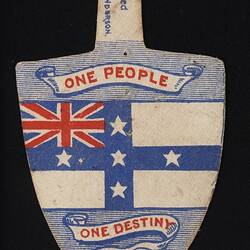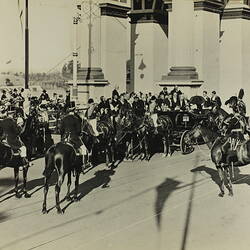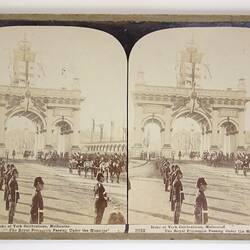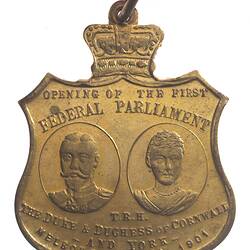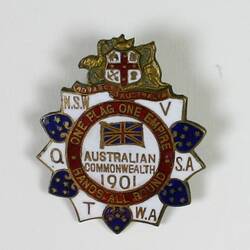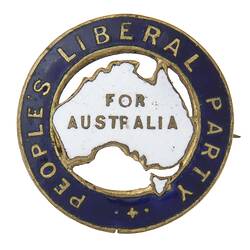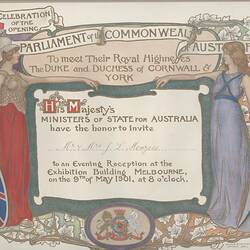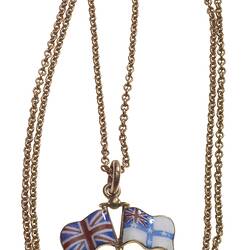Summary
The Commonwealth of Australia was inaugurated on 1st January 1901 in Centennial Park, Sydney. In March, elections were held for the new Federal Parliament, and in May the celebrations focused on Melbourne, where the first Federal Parliament was opened in the (Royal) Exhibition Building. Four months later, Australia's national flag was flown for the first time from the dome of the (Royal) Exhibition Building.
'The coming Australian Commonwealth will need a Flag, and many efforts are already being made to evolve a graceful, characteristic, and effective national symbol; a Flag which shall at once express kinship with the Empire and yet be characteristic of the new and great political entity which has come into existence.' (Advertisement for a flag competition, 20 October 1900)
Flags are symbolic representations of nations, groups of people and institutions. Each part of a flag has a meaning, but these meanings are often contested and change over time. The graphic language of flags comes from the practice of heraldry, which was invented in the Middle Ages as a way of identifying armies on the battlefield. Modern national flags developed as part of nationalist movements in the eighteenth, nineteenth and twentieth centuries. Today, every nation in the world has its own flag.
The current Australian flag is derived from the British blue ensign, traditionally used on ships of the British Empire. Underneath the Union Jack, the national flag of the United Kingdom, sits the Commonwealth star. Its seven points represent the six states of Australia and all the Australian Commonwealth territories. The flag also includes the Southern Cross, a constellation with a long symbolic association with Australia.
Australian flags before Federation
Before Federation in 1901, colonies flew the Union Jack, or their colonial flags, which consisted of the British blue ensign with the colonial seal on the viewer's right hand side. A red ensign was used for merchant shipping. There was no official flag to represent the whole of the Australian continent. The Federation flag was sometimes flown to represent all the Australian colonies, but it was an unofficial flag. It remained popular for many years after Federation. The Southern Cross on the Federation flag resembled that on the Eureka flag, used by miners in Ballarat in the Eureka Stockade of 1854, and there were many other flags that also used this popular symbol.
Choosing an Australian flag
On 9 May 1901, when the first Federal Parliament was opened, Australia still had no national flag.
Interestingly, the pressure to select an Australian flag came from the Imperial authorities in London, who had received numerous inquiries and suggestions on the matter. They had written to the Governor General in November 1900, strongly suggesting that the government should act on the issue.
At a federal cabinet meeting on 13 April 1901 it was decided that a government flag competition would be held. There had already been two national flag competitions run by Melbourne newspapers, the Herald Standard and the Review of Reviews of Australasia. In the government competition there would be no directions as to what could or could not be in the flag design, and the anonymous entries were to be judged by a board appointed by the government. A competition for the design of the national seal was held simultaneously.
The competition was announced to the public on 29 April and entries closed on 31 May 1901. The Review of Reviews, whose competition was still running, decided that it would send the entries it had received to the government competition. In all, 32 823 entries were submitted and displayed in Melbourne's Exhibition Building.
The first raising of the Australian flag - 3 September 1901
On 3 September 1901, the winning design was announced, and flown for the first time from the dome of the Exhibition Building. The board of judges had chosen a design submitted by five separate competitors:
- Miss Annie Dorrington, an artist from Perth
- Mr William Stevens, a ships officer from Auckland, New Zealand
- Mr Leslie Hawkins, an apprentice optician from Sydney
- Mr Egbert John Nuttall, an architect from Melbourne
- Mr Ivor Evans, a 14-year-old schoolboy from Melbourne
The judges sent a report to the Prime Minister, Edmund Barton, explaining why they had chosen the design. They said that because most of the designs submitted had included the Union Jack and the Southern Cross: 'the only additional emblem required was one representing the federation of the six states ... our task was no easy one, but our desire was to give to the people of our new-born nation a symbol that would be endearing and lasting in its effect, and with that end in view, we hope we have been successful.'
Before the design became the official national flag, however, it had to be sent to London for approval by King Edward VII. On 18 February 1902, Lord Hopetoun, the Governor General, forwarded the winning design, along with the Australian Federation Flag, to London for approval. The King gave the final approval for the blue ensign to be Australia's national flag in late 1902.
Disagreement about the new flag
After the winning design was announced there was some opposition to the choice, revealing the continuing rivalry between New South Wales and Victoria. The new flag was similar to Victoria's colonial flag and some felt it was an attempt by Victoria to dictate the national symbols.
The republican Bulletin complained that the new flag used British symbols and traditions, rather than Australian ones. It wrote: 'The flag proposed as the future emblem of the Commonwealth is vulgar and ill-fitting...with no artistic virtue, no national significance...[it] is a true symbol of Australian opinion, still in large part biased by British traditions, British customs.'
Later use and changes of the flag
The actual design of the flag has changed little over time, but its use and the values associated with it have varied significantly.
Two minor changes to the design occurred in 1908:
- The Commonwealth star was changed from six points to seven points, to represent the Australian territory of New Guinea, acquired in 1902. Papua New Guinea gained its independence in 1975, but the seventh point on the Commonwealth star today represents all Australian territories.
- The number of points on the stars in the Southern Cross constellation were amended so that each of the four larger stars now have seven points, and the smaller star has five points. Previously the stars had nine, eight, seven, six and five points respectively. This change made the flag easier and cheaper to manufacture.
Throughout the early years of the Australian Commonwealth, the appropriate use of the flag was unclear. In 1904, the House of Representatives resolved that the flag should be flown on all Commonwealth public buildings. However, the Minister for Defence refused to allow the Australian Flag to fly on Australian forts and it was not until 1908 that it replaced the Union Jack on forts. In 1924, the Commonwealth Government directed that the Union Jack should always be given precedence to the Australian flag. For many years it was thought to be disloyal to raise the Australian flag without also raising the Union Jack. This was partly because the Australian Flag had been used by Irish Australians, as a statement of anti-British sentiment and as a way of avoiding flying the Union Jack.
There was also confusion about whether to use the blue ensign or the red ensign, the merchant version of the flag. It was thought that the 1904 resolution meant that the blue ensign was only to be used on official Commonwealth buildings, and therefore the red ensign became popular for unofficial use. It was not until 1947 that Australians were officially encouraged to use the blue Australian ensign by Prime Minister Chifley. In 1951 the federal government decided to give a flag to every school to celebrate the fiftieth anniversary of Federation and the blue ensign became more popular and more widely known.
More Information
-
Keywords
-
Authors
-
Article types

